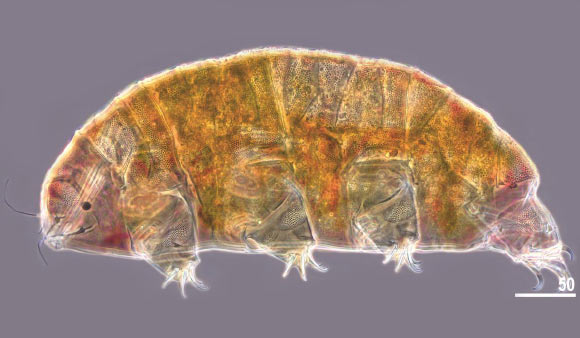New Tardigrade Species Discovered in Kyrgyzstan
Jul 16, 2022 by Natali Anderson
Cornechiniscus mystacinus has catfish-like ‘barbels’ and can be found in the Jalalabat region of Kyrgyzstan.

Cornechiniscus mystacinus. Image credit: Piotr Gąsiorek, doi: 10.1016/j.jcz.2022.06.007.
First discovered in 1773, tardigrades are a diverse group of microscopic invertebrates that are best known for their ability to survive extreme conditions.
Also known as water bears or moss piglets, these creatures can live for up to 60 years, and grow to a maximum size of 0.5 mm, best seen under a microscope.
They are able to survive for up to 30 years without food or water, for a few minutes at temperatures as low as minus 272 degrees Celsius (minus 457 degrees Fahrenheit) or as high as 150 degrees Celsius (302 degrees Fahrenheit), and minus 20 degrees Celsius (minus 4 degrees Fahrenheit) for decades.
They withstand pressures from virtually 0 atm in space up to 1,200 atm at the bottom of the Marianas Trench, and are also resistant to radiation levels up to 5,000-6,200 Gy.
Cornechiniscus is an emblematic genus of large-bodied (over 0.3 mm in length) tardigrades with peculiar, horn-shaped appendages.
Members of this genus typically inhabit mosses and lichens with high amounts of dusty soils, and exposed to frequent and long periods of drought.
They can be found on all continents except for Australasia and Antarctica, with presumably Central Asia as the main place of species diversification.
“Mountains and plateaus of Central Asia harbor a significant number of most probably endemic tardigrade species, yet exploration of the biodiversity of that region has started not long ago,” said study author Piotr Gąsiorek, a researcher in the Department of Invertebrate Evolution at Jagiellonian University.
In the new study, Gąsiorek examined new specimens of Cornechiniscus from Kyrgyzstan, Italy and Argentina.
He determined that one of the tardigrade represented a previously unknown species — the eleventh in its genus.
Named Cornechiniscus mystacinus, it occurs in mountains surrounding Tashkömür in the Jalalabat region of northern Kyrgyzstan.
The species is yellow to dark orange in color, has a massive and plump body, large, round, black crystalline eyes, long peribuccal cirri (sensory filaments), and smooth claws.
Adult females are 0.5 mm long on average; males are more slender than females, and much smaller on average.
“A new Kyrgyz species is dioecious and necessitates modifying the genus diagnosis to accommodate its cirri prolongation that contrasts with bulbous peribuccal cirri typical for Cornechiniscus,” Gąsiorek said.
“Furthermore, it enhances the hypothesis on the Central Asian origin of the genus.”
The discovery of Cornechiniscus mystacinus is reported in a paper in the journal Zoologischer Anzeiger.
_____
Piotr Gąsiorek. Water bear with barbels of a catfish: A new Asian Cornechiniscus (Heterotardigrada: Echiniscidae) illuminates evolution of the genus. Zoologischer Anzeiger, published online July 2, 2022; doi: 10.1016/j.jcz.2022.06.007
Re-posted from: SAci-News http://www.sci-news.com/biology/cornechiniscus-mystacinus-11005.html